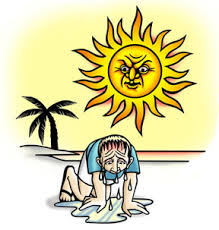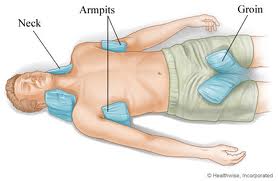 |
|
Hyperthermia is caused by the body's inability to regulate core body temperature. As a result, core body temperature begins to rise significantly. On hot summer days, it is easy for heat exhaustion and hyperthermia to creep up on a sailor who has spent long hours at the helm. Left unattended, it can result in death.
Hyperthermia is progressive. Heat cramps are the mildest form. This can progress to heat exhaustion which is a less serious form of hyperthermia. Heat stroke is the most serious form.
SIGNS OF HEAT EXHAUSTION
- Heavy sweating
- cool moist skin w/goose bumps when in the heat
- faintness
- dizziness
- fatigue
- weak, rapid pulse
- low blood pressure when standing up
Treatment
- stop all activity
- move to a cool location
- drink cool water or a sports drink containing electrolytes
SIGNS OF HEAT STROKE
- skin hot and dry (no longer sweating)
- body temperature above 104F/xC
- confusion and disorientation
Treatment
 |
|
- cover victim with damp/wet sheets
- if symptoms get worse, apply ice or cold compresses to the neck, armpits and groin
Return from HEAT STROKE to FIRST AID
Check out our marine supplies store for First Aid supplies and KN95 Face Masks
Name Brands Quality Products
Click the STORE button on the navigation bar
Join hundreds of fellow
sailors
Subscribe to Rhumb
Line for updates and new port reviews
Your e-mail address is secure.
It is used only
to send you
Rhumb Line
The Complete Log Book For Cruising Sailors
written by a sailor for sailors

a practical, easy-to-use yet thorough format to record all of the necessary information about your boat and any cruises you take – whether exploring home waters or voyaging to distant ports across the Great Lakes.
.
Click here for more details